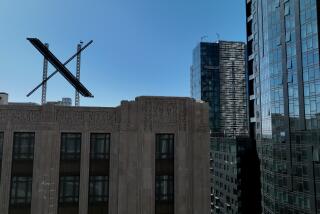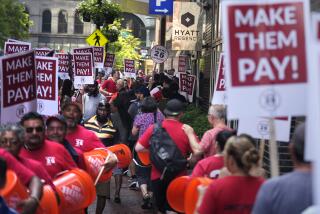As Bay Area Occupancy Rates Drop, So Do Prices
For a few years now, shopping for a hotel room in San Francisco has been something like standing at the foot of Nob Hill and gazing up: In the distance, way up high, you might spy a few gloriously appointed, staggeringly expensive rooms, each already full of gloriously appointed, occasionally staggering guests.
Nob Hill is as steep as ever. But the economic landscape is changing, and many of those upscale hotel rooms these days look much more attainable to leisure travelers. Just as the rest of the city’s economy has slumped in the great dot-com crash, this summer has brought to San Francisco a boost in hotel-room availability and affordability.
“We are starting to see more packaging going on,” said spokeswoman Laurie Armstrong at the San Francisco Convention & Visitors Bureau (Internet https://www.sfvisitor.org). “A lot of hotels are doing special packages. They call them packages rather than discounts. It’s sort of like calling it gaming rather than gambling.”
At the San Francisco-based Joie de Vivre boutique hotel chain, telephone (800) 738-7477, https://jdvhospitality.com, marketing director Rob Delamater said this summer has brought “rates that I’ve never seen before” to some of the city’s most prominent hotels.
Many of his own company’s hotels, Delamater said, showed 10% to 20% declines in occupancy and rates from July 2000 to July 2001.
At Joie de Vivre’s Hotel Rex, the best available rate last September was $155. This September it’s $115 (through San Francisco Reservations, mentioned below). The story is similar for the company’s other hotels: The Hotel Bijou’s best rate last September was $119; this September, $95. For the Maxwell Hotel, the numbers are $169 (including breakfast or parking) versus $139; for the Commodore Hotel, $135 and $95. (These rates apply to a limited number of rooms and are subject to availability.)
In the estimation of Eric Gustavson, general partner at Oakland-based Topaz Hotel Services, “The last time San Francisco room rates were this competitive was during the Gulf War in 1991.”
Topaz is the parent company of San Francisco Reservations, tel. (800) 677-1570, https://www.https://hotelres.com,a company that matches business and leisure travelers with rooms at more than 220 hotels and motels in the Bay Area.
Not every hotelier, however, is marching in lock step on this discounting trend. At the Kimpton Group (https://www.kimptongroup.com), the largest boutique hotel company in the Bay Area, vice president for sales and marketing Jeff Senior said the drop in business travel hasn’t made a big dent in rates. Though occupancy is “down a smidge” at his company’s 16 San Francisco hotels, Senior said, “our rates are flat or even a little bit up since last year.”
At the Sir Francis Drake and Serrano hotels, for instance, September rates begin at $159 a night on weekends, which he said is “within pennies of last year’s rate.”
Another caution for leisure travelers bound for San Francisco is the coming peak convention season. September and October have always been among the strongest months of the year for the city, partly because major conventions are scheduled then, partly because locals say the weather is milder and less foggy. That’s likely to remain true this year. But it’s a dead certainty that for budget-minded consumers, this year is far better than last year.
During the prime weeks of summer, Gustavson said, prevailing rates at Fisherman’s Wharf hotels came down to about $135--rates that last year were around the $200 mark. Some more indicators: In July 2000, he said, San Francisco Reservations arranged 16,600 room-nights in lodgings throughout the city. The average stay was 2.3 days, and the average rate was $148.78.
In July 2001, the company arranged 11,900 room-nights. The average stay was 2.45 nights (which suggests that the balance between business and leisure travelers has tipped toward more leisure travelers). And the average rate was $115.43 per night--a 22% drop from the year before.
If that sounds drastic, consider the numbers at Silicon Valley Reservations, the other Bay Area reservations company run by Topaz. For Silicon Valley hotel bookings, Gustavson said, “our numbers are less than half of what they were the previous year.”
For San Francisco’s hoteliers, the price cutting is hardly a surprise. Occupancy figures have been falling since early 2001 as business travel has dwindled. But many hotels held the line on prices, suggesting that leisure travel to the city, which peaks in summer, would remain stable.
Indeed, a survey by industry analyst PKF Consulting shows that for the first five months of this year, overall hotel rates were running 6.2% ahead of the same period last year, even though occupancy was down 10.9%.
Since May, however, it appears that prices have begun falling in line with those drooping occupancy numbers.
The biggest price drop in San Francisco, Gustavson said, is among major hotel chains like Hilton, Hyatt and Marriott, which make up a big chunk of the 32,000 rooms in the city. (However, those are also the hotels that stand to do best during the coming peak convention season.)
Gustavson noted that the city’s many boutique hotels, usually priced below the chains favored by business travelers, may drop prices less because they typically operate on narrower profit margins.
If you’re thinking about September or October, a few dates to bear in mind: Major conventions include the California Dental Assn. (Sept. 14 to 16; 14,000 conventioneers expected); Seybold electronics expo (Sept. 24 to 28; 25,000 conventioneers); the International Foundation of Employee Benefit Plans (Oct. 5 to 10; 7,000 conventioneers); the American Society of Nephrology (Oct. 12 to 17; 13,000 conventioneers); the American Academy of Pediatrics (Oct. 20 to 23; 10,000 conventioneers); the Infectious Diseases Society of America539512675Nov. 1; 4,000 conventioneers).
One more thing: If you’re tempted to grieve a little for the hoteliers and their misfortune, it may help to add a few more figures to your perspective. PKF Consulting’s Hospitality Research Group, which analyzes the hotel trade’s financial performance, estimates that U.S. hotels enjoyed profit margins of 24.2% during the last 30 years, and it forecasts an average margin of 30.8% in 2001. In other words, from every dollar you spend renting a room, the hotelier takes away an average of 31 cents in profit.
*
Christopher Reynolds welcomes suggestions, but he cannot respond to letters and telephone calls. Address comments to Travel Insider, Los Angeles Times, 202 W. 1st St., Los Angeles, CA 90012; e-mail chris.reynolds@latimes.com.
More to Read
Sign up for The Wild
We’ll help you find the best places to hike, bike and run, as well as the perfect silent spots for meditation and yoga.
You may occasionally receive promotional content from the Los Angeles Times.







